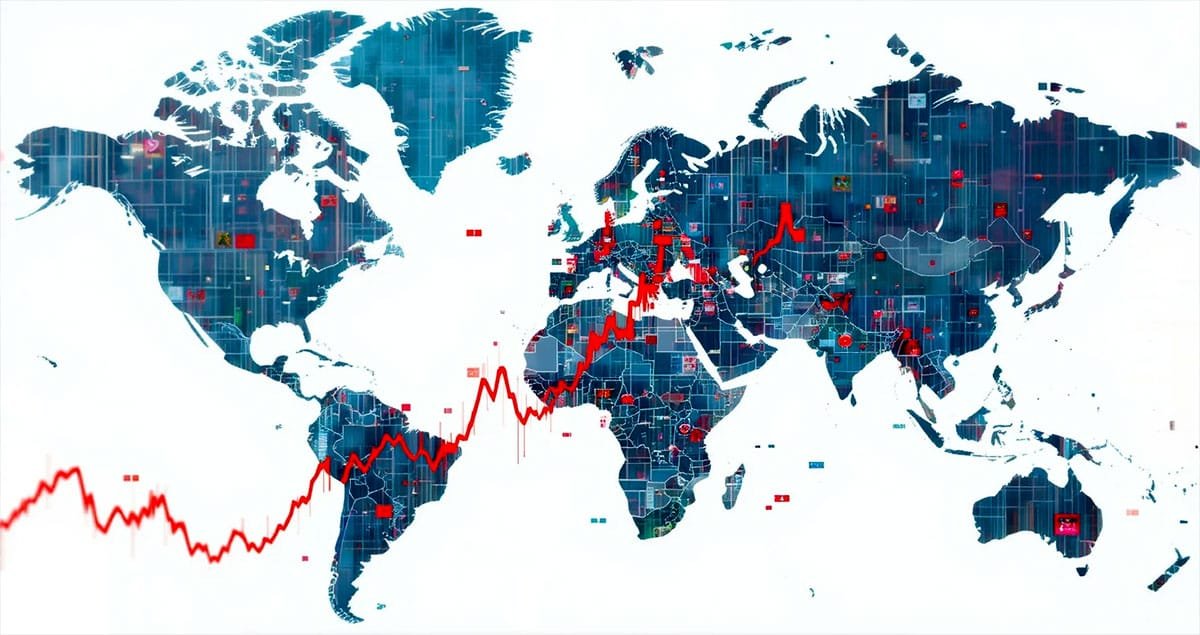Introduction to the Nikkei 225
The official title of the Nikkei Stock Average is Nikkei 225 because it functions as Japan’s primary stock market index through evaluation of the performance of 225 significant listed corporations on the Tokyo Stock Exchange (TSE). In operation since 1950, the Nikkei 225 became the primary instrument for Japanese economic health assessment while providing vital market data to global investors. The price weightings in this index give higher-cost stocks a stronger influence on index values than lower-cost stocks. The applied methodology focuses on the most significant Japanese corporations listed on the Tokyo Stock Exchange due to its effectiveness in market trend evaluation by investors.

Japanese businesses of the four major industrial sectors comprise the Nikkei 225 benchmark, which showcases the diverse economic activities throughout the nation. Investors, alongside market analysts, consider this index important since it incorporates major corporations such as Toyota alongside Sony and SoftBank. The Nikkei 225 index performance influences foreign trading strategies and investment patterns outside Japan through worldwide economic indicators and market sentiment correlations.
The Nikkei 225 passed through different developmental stages, beginning with its price explosion in the late 1980s before experiencing challenges during Japan’s economic slowdown in the 1990s. The Japanese corporate sector has consistently displayed power through different index adjustments that accommodated changing market dynamics and investor preferences since its creation. The following text investigates present-day top-performing Nikkei 225 stocks to examine their success elements and market effects for future periods.
Understanding the Components of the Nikkei 225
Japanese stock market index Nikkei 225 includes numerous components that represent various economic sectors throughout the Japanese economy. Japanese large-cap stocks receive their performance analysis from investors primarily through the Nikkei 225 index. Special selection criteria determine the components of the Nikkei 225 to achieve broad marketplace representation.
The Nikkei 225 inclusion requirement demands Tokyo Stock Exchange operations and high liquidity from companies because market accuracy depends on these criteria. The Nikkei 225 Index contains multiple segments with technology, automotive and retail outlets, pharmaceuticals, and financial services among its sectors. Market capitalization takes a dynamic approach in adjusting sector weightings to reflect the size that each sector contributes to the economic output.
The technology, together with the automotive sectors, comprises the largest sections of the Nikkei 225 due to the Japanese economy’s traditional dependency on these sectors. A major section of the technology industry expansion accompanies the key companies that drive index performance. The modifications in index components occur due to worldwide economic conditions that impact sectoral performance within the Nikkei 225 index.
The Nikkei 225 undergoes periodic reviews to evaluate its selection rules for market condition adaptation. The inclusion and exclusion of new companies and diminished market participants enables the index to adapt to present-day economic conditions in Japan. Investors who want to grasp market conditions alongside all available investment opportunities need the Nikkei 225’s flexible nature.
Criteria for Stock Selection: What Makes a Top Performer?
Many factors need consideration for investors to identify leading stocks among the Nikkei 225 index. The size of a company measured by market capitalization serves as a vital indicator because large corporations generally possess the resources and stability needed for economic turbulence. The high resistance to market volatility that comes with larger market capitalization makes these stocks attractive to investors who seek stable returns.

Companies need a price-to-earnings ratio assessment because it provides insight into their market value at present. Stock valuation indicators through lower P/E ratios can demonstrate that its market price is lower than its actual worth, hence showing potential growth prospects for investors. Stock valuation depends on P/E levels, yet higher P/E ratios combine investor faith in substantial upcoming financial performance with potential price overvaluation. Expert analysis demands both a full understanding of ratio operations as well as evaluation of industry norms.
Stock performance evaluation requires an examination of potential growth opportunities that stockholders may anticipate. Stockholders tend to choose companies with clear indications of prosperous earnings growth prospects because these signs suggest future business success. The combination of innovation spending with market share growth reveals companies that grasp current economic scenarios and consumer needs because it generates better business expansion potential.
The dividend yield acts as a fingerprint that reveals how financially fit a firm remains while maintaining its dedication to shareholder valuation. Investors who need passive income frequently choose stocks that yield dividends consistently and attractively. A high yield demands scrutiny since plummeting stock prices may signify hidden problems within the company.
The financial state, along with existing market movements, significantly affects how stocks perform in the market. The value of stocks is substantially affected by varying interest rates, together with consumer market trends and global economic patterns. The current economic recovery phase following COVID-19 has led to enhanced performance in the technology and healthcare sectors of the Nikkei 225 because demand has increased. These criteria create an extensive system for determining leading performers among Nikkei 225 companies.
Top Nikkei 225 Stocks: Analyzing Performance
The Nikkei 225 index features different stocks that exceeded their peer performance during the recent market period. We will investigate the index’s top-performing stocks through assessment of their market data-driven performance history and economic status, as well as their prospective growth outlooks.

Tokyo Electron Limited leads the way since it demonstrates strong demand-driven performance in the semiconductor manufacturing sector. Japanese authorities report a 20% rise in stock prices for the last six months because the company delivered stronger-than-expected quarterly earnings during this period. Market expansion in this industry will continue with support from technological advancements and increased financial commitment.
SoftBank Group Corp. makes its mark with its major technology company investments throughout worldwide markets. SoftBank Group Corp.’s stock recovered from market fluctuations by demonstrating a 15% increase during its last quarter. SoftBank earns investor approval because the company divested assets while focusing on developing AI-driven businesses.
Fast Retailing Co., Ltd. stands as one of the dominant corporations that maintains its place on the Nikkei 225 index through its management of Uniqlo operations. During this period, SoftBank’s share price rose by 12% because the company achieved strong online sales results alongside steady worldwide market demand. The company demonstrates strong revenue expansion based on financial records, which creates positive conditions for future fiscal performance.
Keyence Corporation stands out because of its robust financial stability and advanced product line, along with stocks like Fujitsu Limited and Fast Retailing Company Limited. The stock achieved approximately 18% annual growth, although its financial health maintained stability because clients from multiple industrial sectors actively demanded its products. The company’s ability to thrive demonstrates Keyence’s success as a market leader.
This evaluation of top Nikkei 225 stocks demonstrates a thriving market because of dominant technological progress, along with strategic business moves. Investors who target the Japanese equity market should consider these companies, which display fundamental strength and strong prospects for future expansion.
Sector Performance: Which Sectors Are Leading?
The Nikkei 225 benchmark tracks all economic sectors encompassing the Japanese market. Market sentiment, together with economic indicators, drives the main changes in sector performance across the Japanese economy. The contemporary business environment demonstrates control by three sectors, comprising the technology sector, the healthcare sector, and the consumer discretionary sector, which demonstrates their capacity to adapt in an evolving economic structure.

The Nikkei 225’s technology sector has demonstrated striking expansion because digital solutions and innovation needs from the market continue to rise. The worldwide use of cloud services with artificial intelligence developments generates ideal market conditions for sector organizations to obtain large financial results. Rising investments accompany technological progress, which lifts stock prices and generates greater confidence among investors toward technology companies.
Healthcare services attract market investors and stakeholders. The aged demographics of people in Japan drive healthcare product needs that companies within pharmaceuticals and medical devices battle for leadership. Market performance receives substantial benefits from rapid advances in research and development by emerging biotechnology companies.
The recovery of consumer discretionary appears robust since markets experienced rising consumer spending along with retail expansion after pandemic restrictions. The improved employment situation and higher salaries have created additional household resources that people use to spend on non-essential items. Companies continue to achieve notable financial success through market trends in e-commerce and lifestyle items since consumers prefer digital shopping platforms and experiential living experiences.
A thorough performance comparison between sectors exists within a table that presents growth rates, market capitalization, and stock movement data. The visual presentation serves as a business overview tool that helps investors spot market trends in the Nikkei 225 and its major sectors.
Investment Strategies for Nikkei 225 Stocks
Investors should apply structured plans when dealing with Nikkei 225 stock opportunities and difficulties because they exist simultaneously. Current investment approaches fulfill the requirements of different market conditions and investment aims. Investors primarily use value investing alongside growth investing and sector rotation approaches to perform their activities.
Value investors analyze Nikkei 225 stocks to locate securities that sell for less than their actual value. Investors identify potential opportunities by combining the price-to-earnings ratio and market valuation assessments. Guaranteeing profit through stock acquisitions at reduced prices enables investors to derive value from market valuation correction events. Investors who want to excel in this approach must devote thorough analysis combined with deep knowledge about business fundamentals.
The focus of growth investing involves selecting Nikkei 225 companies that demonstrate solid predicted earnings expansion prospects. The search for stocks by investors targets companies showing essential growth factors, including both increased revenue numbers and regular innovative development. Long-term success in equity investments demands patience because investors should maintain their positions to receive gradual price appreciation rather than immediate profits.
Investors make profits through sector rotation strategies, which allow them to benefit from market cyclicality. The analysis of economic indicators enables investors to choose specific sectors from the Nikkei 225 that will deliver superior results during different market conditions. To implement this strategy, investors need deep knowledge about market trend development, together with economic indicator analysis.
- Investors must thoroughly research stocks from the Nikkei stock market before placing capital in them.
- Investors should spread their funds across various industrial sectors to minimize their risk exposure.
- The strategic plan of Industrial Basin demands continuous monitoring of market developments to achieve successful modifications.
- The method calls for extended view planning instead of spontaneous choices.
Through the implementation of these strategies and best practices, new and experienced investors will improve their potential for success when dealing with the Nikkei 225 market.
The Impact of Global Events on the Nikkei 225
Japan’s main index, which gathers the data from its top companies, shows high sensitivity to worldwide events such as economic shockwaves and political tensions as well as natural disasters. Studies regarding these impacts fulfill essential requirements for market professionals, including analysts and investors. The Nikkei 225 reacts strongly to global situations based on historical performance data since its market participants evaluate international conditions.

The financial crisis of 2008 caused severe damage to Nikkei 225 stock prices. Market prices from various sectors, including tech and export businesses, rapidly declined when investor confidence plunged because of the global credit crisis. Foreign market demand, together with declining Japanese economic expectations, led to an immediate index drop. The occurrence demonstrated that powerfully interlinked international economies share direct relationships that result in external forces affecting national stock market values.
Stock prices on the Nikkei 225 demonstrate clear effects from the ongoing trade tensions between the United States and China. News updates from trade relations and tariffs led to stock price volatility within the Nikkei 225 because investors needed to redirect their capital based on evolving trade uncertainties. The market experienced negative performance because businesses predicted export declines, which led to reduced profit potential.
Natural disasters continue to influence the history of the Nikkei 225’s performance, as they have been responsible for its development. Japan’s infrastructure and economy suffered major destruction because of the 2011 earthquake and tsunami sequence. Businesses from the retail and manufacturing sectors, along with other index stocks, experienced substantial value declines because of disrupted supply chains caused by the natural disasters. Any sudden global event can radically change market dynamics according to the immediate and eventual results of certain sectors.
Research shows that performance data from the Nikkei 225 stands in direct connection to worldwide events. Investors must demonstrate high alertness toward world developments because these correlations show their portfolios can face substantial changes.
Future Outlook and Predictions for Nikkei 225 Stocks
Market analysts center their focus on Nikkei 225 stocks because of emerging economic situations and worldwide market changes. Expert analysis shows that various factors are set to determine the performance of this major stock index. The monetary policy from Japan will play a vital role through its accommodative stance because it aims to bolster economic expansion despite international economic uncertainties.

Market analysts believe technology and green energy markets will experience strong performance since Japan advances digitally and supports sustainable development initiatives. Technology solutions demand is rising globally, so multiple Nikkei 225 company members expect to profit highly from this trend. Renewable energy corporations will receive growing investment support since Japan aims to meet its 2050 carbon neutrality targets more stringently.
Factors with promising market growth potential consist of:
- The Nikkei 225 will experience improved corporate earnings through sustained investor spending and business capital investments within the market.
- A stable relationship between Japanese exporters and trade partners, the United States and China, provides beneficial conditions in the market.
- The continuing development of corporate governance systems creates better investor trust, which finally raises prices for top-tier stocks.
The forecast remains vulnerable to various internal dangers that might affect its results. The forecast faces two main risks, such as geopolitical tensions that might interrupt supply lines, while Japanese exports endure exchange rate changes. Worldwide market conditions demand investors remain watchful by making informed decisions among cautious financial management of their funds.
Market analysts maintain faith in Nikkei 225 stock trends, although continuous tracking of economic developments along with market trends remains vital for making future investment decisions.
Conclusion: The Nikkei 225 in Perspective
The Nikkei 225 functions as a fundamental equity index for Japanese stock market performance analysis, which simultaneously reveals important global economic signals. Various leading stocks listed on the Nikkei 225 have proven to be major market players who produce strong financial results while shifting investor perceptions in Japanese and international markets. The Japanese stock market features Toyota, Sony, and SoftBank as examples of companies that demonstrate adaptiveness and resilience through their innovations and technology expertise in manufacturing.
Japanese economic success relies on these leading firms, while their global market control extends to multiple industries worldwide. Investors rely on the Nikkei 225 as their primary tool for assessing Asian market performance, together with real-time evaluation of changing global market patterns. The integrated nature of markets creates extensive effects from Nikkei movements, which demand that investors constantly track these financial developments.
Those who intend to handle the intricate aspects of the Nikkei 225 will need to dedicate themselves to persistent learning and interpretation of market developments. Successful traders must comprehend both the core economic factors affecting stock prices, along with all the relevant economic variables operating in the market. When investors track the dominant stocks on the Nikkei 225, they obtain better information that enables them to make decisions matching their financial planning. Investors who grasp the significance of leading Nikkei 225 stocks improve their capacity to identify market-based investment opportunities in this dynamic economic environment.




